
History-missionary project
Missionaries in the Hong Kong Mission move their luggage toward the check-in counter in the airport as they evacuate due to growing Coronavirus concerns. Photo courtesy of Dennis L. Phillips, courtesy of Church News.All rights reserved.This story appears here courtesy of TheChurchNews.com. It is not for use by other media.
By Scott Taylor, Church News
A day prior to what would be the February 4 coronavirus-prompted evacuation of the full-time missionaries under his care, President Dennis L. Phillips of the China Hong Kong Mission directed those serving in outlying areas to gather in the city as leaders followed news reports. Missionaries waited for possible word to initiate evacuation procedures.
Confirmation then came. “Jell-O Nation” — the mission’s secret code phrase — signaled the start of the three-task evacuation process: don’t contact anyone, pack up everything, and to clean out your apartment.
With so many directives and so much love and concern to convey to his missionaries, President Phillips did his best with a concise WhatsApp group text: “I wish that I could have told each of you personally, but it wasn’t possible. An announcement was just issued by the Church indicating that due to the impact of the virus, all missionaries serving in Hong Kong will be temporarily reassigned. I will be in touch with each of you shortly, but please do not notify your parents or make calls. This is not because it is a secret, but it will complicate our effort to get you home. Here is the press release. Please read it and then we’ll talk. We love you all and would take you in our arms right now if we were with you.”
The mission’s departure plan took action — creating travel groups of eight to 17 missionaries, supplementing a leased tour bus with taxis, gathering at the mission office, offering nearby apartments when sleep was needed, weighing luggage, discarding excess items, ordering in pizza and allowing missionaries to call home while waiting for designated departure times.
Assistants to the president and office missionaries directed the masses in the mission office, the mission nurse checked the temperature of every elder and sister before they boarded the airport-bound bus, and senior couples assisted at airport check-in lines while providing comfort, security, and — in many cases —credit-card assistance in covering excess-baggage charges.
The mission included 13 local elders and sisters from Hong Kong who were to be temporarily released. President Phillips and his companion, Sister May Phillips, hoped to ease any sense of abandonment by inviting them and their parents to meet at the chapel at mission headquarters for an evening of explanations and expressions and to return for lunch the next day.
“I am sure there are some things we could have done more efficiently or better, but we definitely saw the Lord’s hand in this work. Things just worked very well, and even when mistakes were made or overlooked, we were able to quickly adjust and make it work,” President Phillips later wrote. “… “We are even more convinced that there is a divinely inspired plan. We have had to learn patience and persevering way beyond anything we thought was possible.”
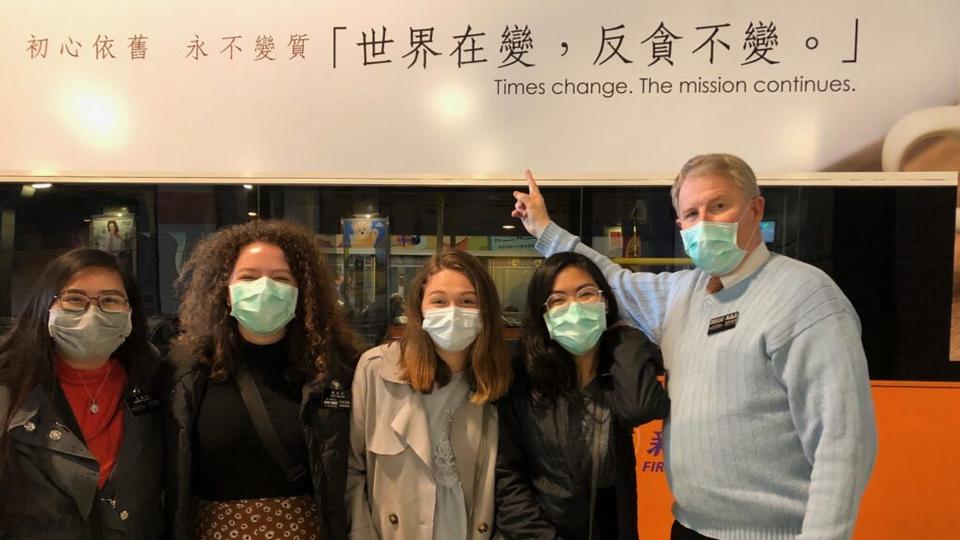
History-Missionary project
In the days before his missionaries evacuate due to coronavirus concerns, President Dennis L. Phillips of the China Hong Kong Mission finds some humor in an overhead advertisement in a photo with several sisters. Photo courtesy of Dennis L. Phillips, courtesy of Church News.All rights reserved.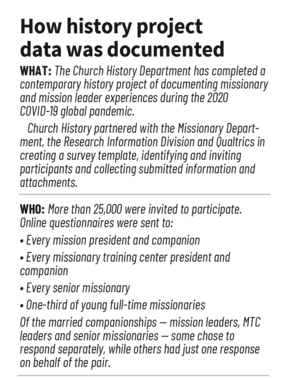
▢ ▢ ▢ ▢ ▢
President Phillips’ account of the Church’s first of many coronavirus-related mission evacuations is an excerpt of one of nearly 7,000 submissions by mission leaders and missionaries of The Church of Jesus Christ of Latter-day Saints as they shared experiences and impressions of how the 2020 COVID-19 global pandemic impacted missionary work.
▢ ▢ ▢ ▢ ▢
At an Arizona Phoenix Mission leadership council meeting, Elder Jon Ferguson listened as his mission president became emotional mentioning an email from the day before about the Church’s pandemic-related adjustments to missionary work. Those included the early release of elders scheduled to complete their missions on or before Sept. 1, ending their service at 21 months instead of 24.
“He started reading slowly the names of all the missionaries who would be affected. As those missionaries stood up, you recognized them as some of the hardest-working, most obedient missionaries in the room,” Elder Ferguson wrote.
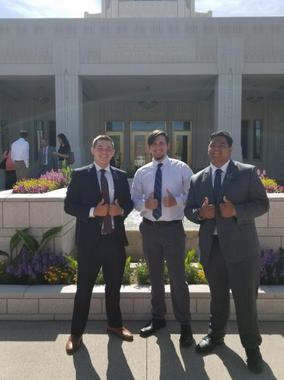
History-missionary project
Elder Jon Ferguson, left, of the Arizona Phoenix Mission, stands outside the Phoenix Arizona Temple during his COVID-shortened service as a missionary. Photo courtesy of Jon Ferguson, courtesy of Church News.All rights reserved.“As he read slowly the names, it got to me. It felt like my heart was crushed, I broke down, I couldn’t even speak. I just felt hurt and broken as I looked at my close friends, missionaries I had worked closely with, also going through the same emotions I was. I felt pretty hopeless.”
He noted “a tender mercy” — a Samoan missionary who Elder Ferguson had trained was in attendance. “As I was going through this, he picked up his seat and brought it to mine a few rows away — he came and just put his arm around me. It helped me feel more of God’s love, and it touched me deeply.”
Elder Ferguson reported trying over the next several days to cope and accept the news, “which broke me until I was able to really pray and know it was God’s plan.” After a week’s time, his perspective changed, “and I was given a new encouragement to give the last few months I had and work hard enough to where the Lord knew I served with all my heart, might, mind and strength.”
▢ ▢ ▢ ▢ ▢
Crosby noted that not only was gathering a contemporary history unusual, so was an online survey to collect extensive information. “In this case, we wanted to gather narratives — not just ‘yes’ or ‘no’ answers — and then save that forever.”
Combining the template with the individual’s name, mission, membership number and contact information, survey responses and attachments are brought into Church History’s preservation system, where information can be filtered, sorted and stored in many different ways.
▢ ▢ ▢ ▢ ▢
Sister Nemah Agamata of the Cambodia Phnom Penh Mission was serving 12 hours away from the city headquarters when she and others received word that all non-Khmer missionaries were to pack and travel to the mission home immediately. Border closings delayed her and fellow Filipino missionaries a week after North American missionaries had departed home.
“We need to follow the instruction that we need to go home and continue our service in our own nation. I love my country, but serving in the place I was first called to serve made me who I am today. Leaving is hard, but we need to obey,” wrote Sister Agamata, adding that she wasn’t able to reach members and friends she was teaching until she was at the Manila MTC for two weeks of quarantine.
Released and awaiting a reassignment to finish her last six months in her native Philippines, she acknowledged the challenges of not having access to the technology she used as a missionary and being in a home where she’s the only active Latter-day Saint. “Thinking of removing my nametag and being released is sad,” she wrote, expressing faith in God. “It’s hard to be in my situation now, but I have trust in His plan. This is one of the reasons why I still have my hopes up so high.”
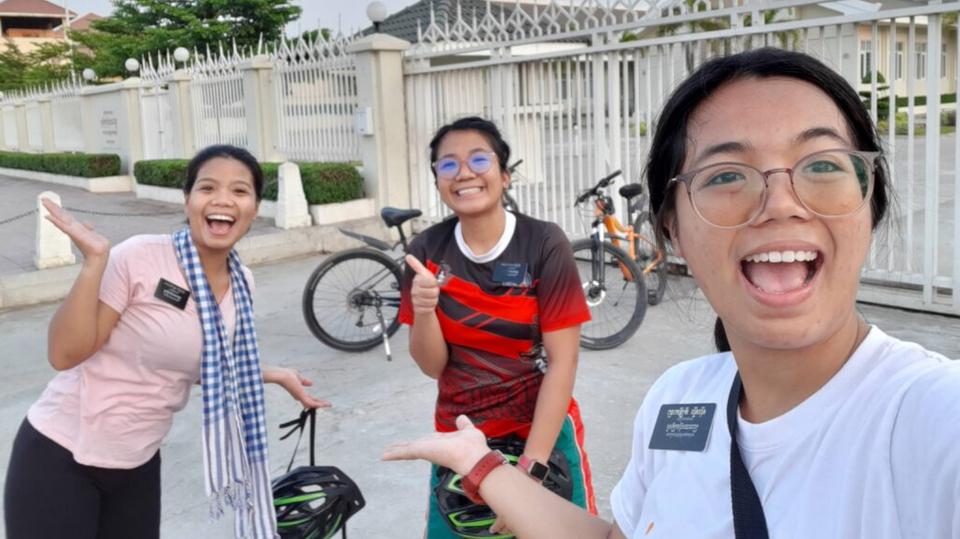
History-missionary project
Sister missionaries of the Cambodia Phnom Penh Mission pause for a selfie. Photo courtesy of Sister Nemah Agamata, courtesy of Church News.All rights reserved.▢ ▢ ▢ ▢ ▢
Crosby said project supervisors noticed a few common themes. Senior missionaries and young full-time missionaries loved their missions and wanted to stay, rather than to return home for release or reassignment.
Meanwhile, senior couples often came home to challenging situations, such as their homes being rented out or used by extended family for the planned duration of their service, so they didn’t have a place to come home to and needed to figure out where to do their two-week quarantine.
▢ ▢ ▢ ▢ ▢
Sister Joyce Havens, a senior missionary with her husband, Elder Gary Havens, in the Tahiti Papeete Mission, chronicled how a pandemic prohibition on groups larger than 10 and the closure of Church buildings resulted in missionaries unable to watch the April 2020 general conference in meetinghouses or member homes. And the mission-issued models of cellphones didn’t allow missionaries to access the internet to listen.
The week before, 80 missionaries returned home, and the mission collected a total of 19 phones from them. A couple at the mission office thought of setting up a unique “conference call” — “to set up conference at the mission office on the mission computers, and then have the missionaries call a phone that was set up near the computer so they could listen in on conference,” wrote Sister Havens.
“The little miracle was we had collected 19 phones, which was the exact number of phones we needed to have available for the missionaries to call into. We were able to set up an English and French session so people could listen in their preferred language.”
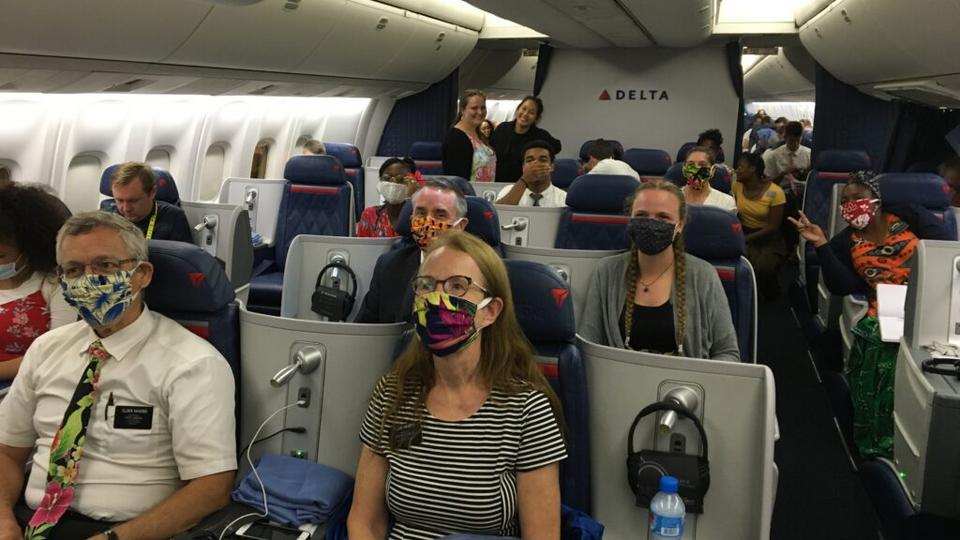
History-missionary project
Missionaries are on board a flight during a pandemic-prompted departure from the Tahiti Papeete Mission. Photo by Sister Joyce Havens, courtesy of Church News. All rights reserved.▢ ▢ ▢ ▢ ▢
Survey submissions covered different periods of the pandemic, Crosby said, noting that most senior missionaries returned before a global sense of urgency, with airports not yet in lockdown, compared to many young missionaries given only a day or so — and sometimes just hours — to catch a flight before airports and borders closed.
Responses from young missionaries also varied from those who faced reassignment or early release to those newly called deciding between online training at home and possible reassignment or a mission deferment of up to 18 months.
▢ ▢ ▢ ▢ ▢
Assigned to serve in the Germany Berlin Mission, Sister Annalie Day wrote: “Going into online MTC, I was terrified. I didn’t know if I was going to be able to learn the language as effectively, I was worried that I wouldn’t bond with my district at all because it’s all online, or that I wouldn’t be able to learn about what to teach as effectively.”
Then the Church offered the option for missionaries to either continue with their original service dates or to defer. Facing the “hard decision,” she prayed and fasted and was still unsure.
“But then I got a prompting from the Lord saying that now was the right time for me to go. I needed to go because there was someone who needed me now. Not in 18 months. It was an awesome experience, and I’m glad it happened because I wouldn’t change it for the world.”
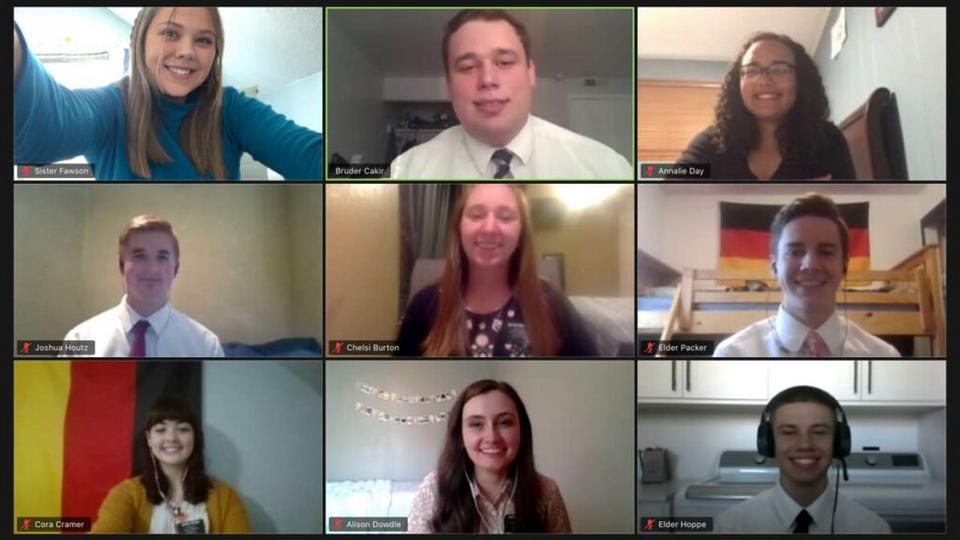
History-missionary project
A district of missionaries gather in a video conference for online MTC training in the Germany Berlin Mission. Photo courtesy of Sister Annalie Day, top right, courtesy of Church News. All rights reserved.▢ ▢ ▢ ▢ ▢
Mission leaders, Crosby said, faced “logistics that were just unbelievable” in getting missionaries out of the country, balancing between government regulations about social distancing and gathering missionaries in preparation for departures. “It was a real challenge.”
Differences in responses are evident because of geographic location. For example, most missionaries returned to their home countries, but in Europe and Europe East, missionaries generally sheltered in place. And in some locations in Africa, Crosby said, a few missionaries had to flee because of animosities and misunderstandings towards foreign missionaries and a belief that they were bringing COVID into the locales.
▢ ▢ ▢ ▢ ▢
Sister Patricia Espinosa, companion to President Richard O. Espinosa of the Philippines Urdaneta Mission, shared her husband’s experience after the pandemic-rushed departures of non-Filipino missionaries: “‘One evening around 10 p.m., I heard a very clear voice in my head that I should check my Messenger message requests,’” he recounted. There, among the inquiries from missionary parents about flight itineraries, he found one active account that continued to message him. He recognized it as an elder who had already departed for home in Tahiti. Delayed at the Singapore airport for 15 hours, he finally was able to borrow a computer to contact President Espinosa. “He was stranded and didn’t know what to do. He was telling me how stressed he was and was praying hard that I may be able to see his message right away. And, yes, in a matter of a short time, I saw his message.’”
The mission president was able to contact the Church’s travel department and rebook the elder’s flight the following morning through Japan and on to Tahiti. “He said he will never forget this miracle,” wrote Sister Espinosa. “How comforting it is to know that the Lord heard his prayers.”
▢ ▢ ▢ ▢ ▢
Crosby said Elder LeGrand R. Curtis, the Church Historian and Recorder, encouraged the department to look for ways to gather contemporary history and to be on the cutting edge of collecting and preserving. “We’ve been given lots of support,” Crosby added, crediting the partnership of the Missionary Department and the Church’s Correlation Research Division.
“It’s our first attempt to gather history this way — and it has been extremely successful,” he added, explaining that to acquire and catalog over 7,000 individual perspectives would typically require thousands of hours of work. “This new approach has allowed us to gather this important history, but in a way that has taken a fraction of the time.”
▢ ▢ ▢ ▢ ▢
Sister Macy Rideout of the Portugal Lisbon Mission remembers their March zone conference being switched to an online Zoom meeting. Two days later, the call came for the missionaries to go to the store, buy enough food for two weeks and then stay inside — “and we’ve been here since March 12,” she wrote.
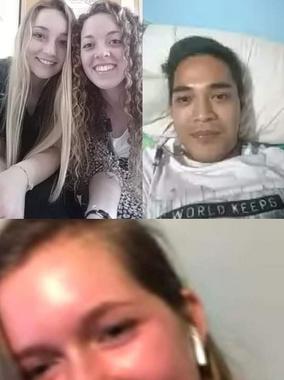
History-missionary project
Sister Macy Rideout and Sister Madeline Ashton, upper left, of the Portugal Lisbon Mission, join in an online teaching moment with a Filipino man they became acquainted with via Facebook and a friend of the missionaries who had returned home from the Philippines and could translate their messages in Tagalog. Photo courtesy of Madeline Ashton, courtesy of Church News. All rights reserved.“During this time in quarantine, I am growing in wisdom, judgment and knowledge, being refined by the grace of my Savior Jesus Christ,” Sister Rideout continued, “but this does not exclude the fear that I had of possibly leaving my mission, the anxiousness I felt completely changing the way we had been working, or the difficult feeling I had of not wanting to work.
“But no trial we face, pain that we suffer or difficulty we endure is ever wasted. … All that we face, all that we endure, especially when we endure it patiently, expands our souls and purifies our heart. I would never change what I have experienced and what I have felt during my time in quarantine.”
Sister Madeline Ashton, Sister Rideout’s companion in Portugal, detailed in her survey submission how the two used social media platforms to find, contact and teach individuals during their self-isolation. One connection came through Facebook, where they found the man was from the Philippines; Sister Rideout had a friend just home from the Philippines who spoke Tagalog.
“So we introduced them and taught a lesson with her,” wrote Sister Ashton, adding that a day after the man committed to pray to know if Joseph Smith was a prophet, the man messaged to say that he knew that God calls prophets and how much they were needed now to lead and guide. “It is such a blessing that we have technology to find people all around the world and use people from home to help as well.”
▢ ▢ ▢ ▢ ▢
Crosby calls the Church History’s project “chapter one” of an ongoing effort to document missionary experiences during the pandemic; other elements will include interviews with the Church’s Missionary Executive Council, area leaders and Missionary Department officials.
Also factored in will be the unit histories submitted by more than 400 missions, which will be replete with pandemic-related adjustments, experiences and learnings.
▢ ▢ ▢ ▢ ▢
Elder Kasey Price had been in the Honduras Tegucigalpa Mission for about three months when pandemic adjustments, returns and releases started. He completed his survey submission after returning home, being temporarily released and waiting to be reassigned.
“At this point in time, I feel hopeful,” he wrote. “I know that the Lord has a plan for me. He knows where I am, He knows what I am feeling (probably better than I do), and He knows what the next step is. I am confused at what to think and what will happen next.
“I am frustrated that I don’t know. I am scared that I didn’t do all I could in Honduras. I am happy that I got to be even a little part of people’s lives down in the little town of Triunfo. I am excited to see where I get reassigned to. I am nervous that I’m not up for the task or that I won’t be enough. But overall, I am full of love. … l feel hopeful and full of love for our Father in Heaven who loves us and knows where we need to be.”
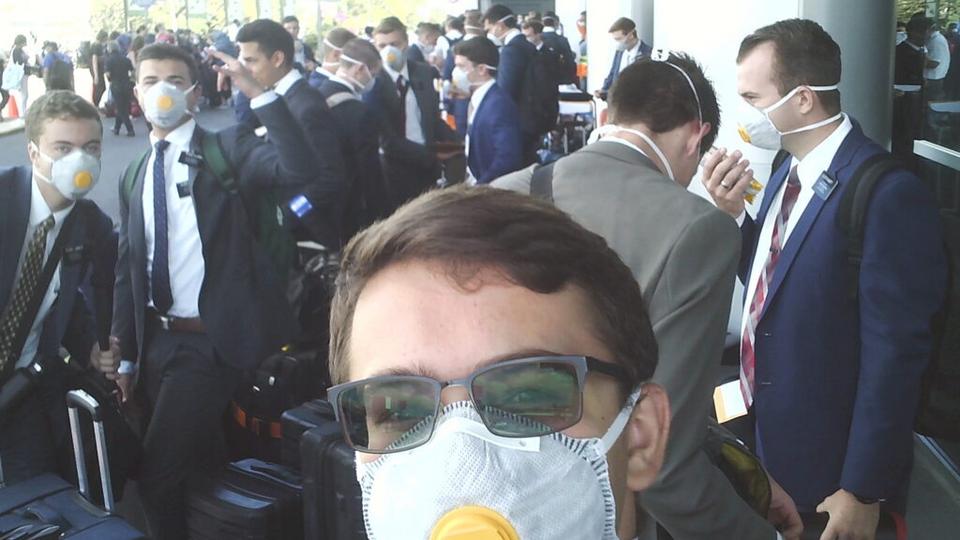
History-missionary project
Elder Kasey Price, center, of the Honduras Tegucigalpa Mission, takes a selfie during the pandemic-related departure of missionaries. Photo courtesy of Kasey Price, courtesy of Church News.All rights reserved.▢ ▢ ▢ ▢ ▢
Crosby said, “We learn from the past — we see examples of how people faced trials and how they got through them, that God doesn’t leave us alone, that He’s there to help us through our trials.
“We think there’s a strong connection between history and covenants — because in a covenant, you’ve got to trust that God will do His part if you do your own part. And history gives us lots of examples of where He’s always done His part, and so it should increase our trust that all will work out if we persevere.”
▢ ▢ ▢ ▢ ▢
Sister Linda Hsiung of the China Hong Kong Mission explained how her experiences spanned multiple locations, from the Provo MTC to a temporary assignment because of political protests in Hong Kong and the global pandemic forcing her to return home — with three hours’ notice before departure — and then resume her service in Massachusetts.
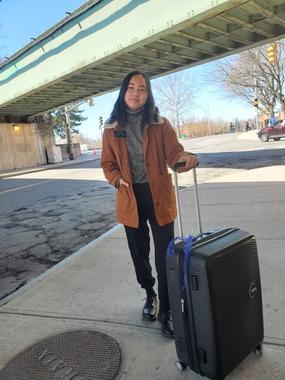
History-missionary project
Seeing Sister Linda Hsiung of the China Hong Kong Mission with suitcase close at hand was a common sight — her full-time missionary locations included training in Provo, being temporarily assigned in Denver, serving in Hong Kong, returning home to California and then being reassigned to Boston. Photo courtesy of Church News.All rights reserved.“Never would I have ever guessed that my mission experience would involve going from Utah to Colorado to Hong Kong, back home to California and then to Boston,” she wrote, “but there’s nothing I can complain about. I’m doing the most important work on the earth right now, alongside the Prophet and his Apostles. Wherever that may be, there are souls to be saved, and I know one of those has been my own as well.”
She added, “All three of my mission presidents have been so different but so inspired for the specific missions they preside over. I think because this is my third assignment, I’ve been able to get the hang of adjusting to a new mission. … I realized the best way to adjust is to simply throw yourself into the work and be as loyal as you can to your new mission president. Serve as if you’re going to serve there for the rest of your mission.”
Copyright 2020 Deseret News Publishing Company